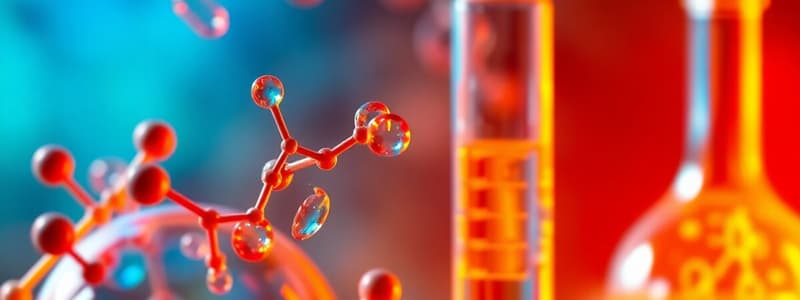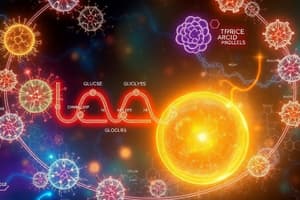Podcast
Questions and Answers
What is the result of an oxygen atom sharing its outer shell electrons with two hydrogen atoms?
What is the result of an oxygen atom sharing its outer shell electrons with two hydrogen atoms?
- Formation of an anion and a cation
- Formation of an acid
- Ionization
- Formation of a molecule of water (correct)
Which of the following best describes a measurement of hydrogen ion concentration?
Which of the following best describes a measurement of hydrogen ion concentration?
- Atomic mass
- pH (correct)
- Atomic number
- Isotope
If an atom has 4 protons, 4 neutrons, and 4 electrons, what is its atomic mass?
If an atom has 4 protons, 4 neutrons, and 4 electrons, what is its atomic mass?
- 16
- 12
- 8 (correct)
- 4
What is the term for the sharing of electrons between atoms?
What is the term for the sharing of electrons between atoms?
What is the pH value considered neutral?
What is the pH value considered neutral?
What kind of ion has 8 protons and 9 electrons?
What kind of ion has 8 protons and 9 electrons?
What is the process by which NaCl dissociates into Na+ and Cl- called?
What is the process by which NaCl dissociates into Na+ and Cl- called?
What is the function of a catalyst?
What is the function of a catalyst?
What is the primary role of an enzyme in a biological system?
What is the primary role of an enzyme in a biological system?
Two atoms both have 3 protons and 3 electrons, but the first has 4 neutrons and the second has 3 neutrons. What term best describes this relationship?
Two atoms both have 3 protons and 3 electrons, but the first has 4 neutrons and the second has 3 neutrons. What term best describes this relationship?
If hydrochloric acid (HCl) is added to a solution with an initial pH of 7.45, what is the expected outcome?
If hydrochloric acid (HCl) is added to a solution with an initial pH of 7.45, what is the expected outcome?
Which statement is correct regarding Na+?
Which statement is correct regarding Na+?
Given that blood typically has a pH range of 7.35 to 7.45, what does this indicate about its nature?
Given that blood typically has a pH range of 7.35 to 7.45, what does this indicate about its nature?
What term accurately describes a solution where alcohol serves as the solvent?
What term accurately describes a solution where alcohol serves as the solvent?
Which of these ions is classified as an anion?
Which of these ions is classified as an anion?
Which of the following is considered a waste product of cellular metabolism?
Which of the following is considered a waste product of cellular metabolism?
Flashcards
What is the function of an enzyme?
What is the function of an enzyme?
A substance that speeds up a chemical reaction without being consumed in the process. Enzymes are biological catalysts, typically proteins that facilitate specific chemical reactions in living organisms.
What are isotopes?
What are isotopes?
Atoms of the same element that have the same number of protons but different numbers of neutrons. They have the same atomic number but different atomic masses.
What happens to the pH of a solution when an acid is added?
What happens to the pH of a solution when an acid is added?
The addition of an acid to a solution with a pH of 7.45 will increase the concentration of hydrogen ions (H+) in the solution, making it more acidic. This will lower the pH of the solution.
What is a cation?
What is a cation?
Signup and view all the flashcards
What is a tincture?
What is a tincture?
Signup and view all the flashcards
What is an anion?
What is an anion?
Signup and view all the flashcards
What is a mixture?
What is a mixture?
Signup and view all the flashcards
Which solution has a higher concentration of hydrogen ions, acidic or alkaline?
Which solution has a higher concentration of hydrogen ions, acidic or alkaline?
Signup and view all the flashcards
What is pH?
What is pH?
Signup and view all the flashcards
What is a neutral pH?
What is a neutral pH?
Signup and view all the flashcards
What type of substance is NaCl?
What type of substance is NaCl?
Signup and view all the flashcards
What is the atomic number?
What is the atomic number?
Signup and view all the flashcards
How is water formed?
How is water formed?
Signup and view all the flashcards
What is the atomic mass of an atom with 4 protons, 4 neutrons, and 4 electrons?
What is the atomic mass of an atom with 4 protons, 4 neutrons, and 4 electrons?
Signup and view all the flashcards
What is the universal solvent?
What is the universal solvent?
Signup and view all the flashcards
What is ionization?
What is ionization?
Signup and view all the flashcards
Study Notes
Enzyme Function
- Enzymes act as catalysts
- Catalysts speed up chemical reactions
Atomic Structure and Isotopes
- Atoms with the same number of protons but different numbers of neutrons are isotopes
- The provided example describes isotopes
Acid-Base Reactions and pH
- Adding HCl to a solution raises [H+] concentration, lowering pH
- A pH of 7.45 in a solution with the addition of HCl would decrease the pH
Ions and Electrolytes
- Na+ is a cation, a positively charged ion
- Na+ is an electrolyte
Blood pH
- Blood pH is 7.35-7.45, making it slightly alkaline (not acidic)
Solutions and Solvents
- A solution with alcohol as the solvent is a tincture
- Water is the universal solvent
Ions (Anions and Cations)
- Chloride (Cl-) is an anion (negatively charged ion)
Cellular Metabolism Waste
- Carbon dioxide (CO2) is a waste product of cellular metabolism
Mixtures
- A combination of sugar and iron filings is a mixture
Anions
- HCO3- (bicarbonate) is an anion
Cations
- A cation is a positively charged ion
Hydrogen Ion Concentration and pH
- A solution with a lower pH has a higher concentration of hydrogen ions ([H+])
Blood pH and Acidity/Alkalinity
- A blood pH of 7.28 indicates acidosis (excess H+)
Bonding Types
- Ionic and covalent bonding describes how atoms form compounds through sharing or swapping electrons
Energy Transfer
- ATP (adenosine triphosphate) is the energy-transferring molecule
Neutral pH
- A neutral pH is 7.00
Electrolytes
- NaCl (table salt) is an electrolyte
pH Measurement
- pH measures the concentration of hydrogen ions ([H+])
Water Formation
- Water forms when oxygen shares electrons with hydrogen atoms
Atomic Mass and Number
- An atom with 4 protons, 4 neutrons, and 4 electrons has an atomic mass of 8 and an atomic number of 4
Water (Chemical Formula)
- Water is formed by one oxygen atom bonded covalently to two hydrogen atoms
pH and Alkalinity
- A solution with a pH of 8 is more alkaline than blood
Ions and Atomic Structure
- An ion with 8 protons and 9 electrons is an anion
Acidic/Alkaline pH
- A solution with a pH of 6.8 is acidic
Catalysts
- Catalysts increase the speed of chemical reactions
Covalent Bonds
- Covalent bonding involves the sharing of electrons
Atomic Components
- Electrons orbit the nucleus of the atom
Universal Solvent
- Water is the universal solvent
Ionization
- Ionization is the dissociation of a compound into its ions (e.g., NaCl into Na+ and Cl-)
Studying That Suits You
Use AI to generate personalized quizzes and flashcards to suit your learning preferences.




